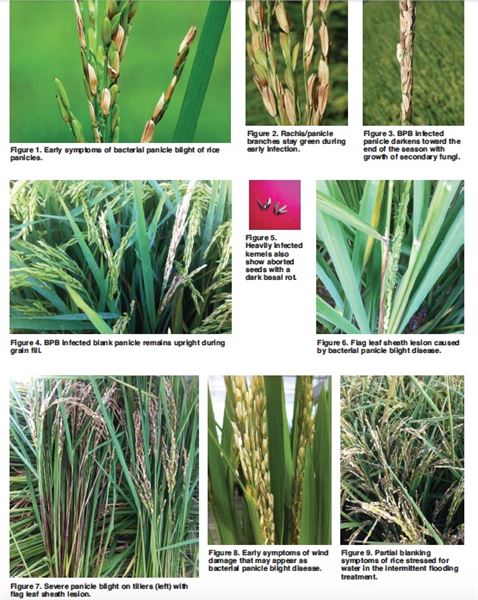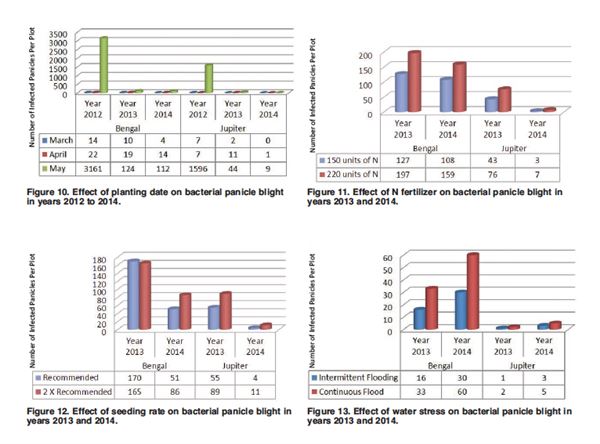Bacterial Panicle Blight Of Rice In Arkansas
DR. YESHI WAMISHE
STUTTGART, ARK.
Bacterial panicle blight (BPB) is an important disease in Arkansas rice that has caused huge losses over the years, including 1995, 2010 and 2011. The cause was identified about 1996 by LSU scientists, but the problem has likely been around for a long time in the United States, often called something else. It came to the forefront in the early to mid-1990s with the introduction of Bengal (highly susceptible), Cypress and Cocodrie varieties.
BPB is caused mainly by Burkholderia glumae but there are probably a couple of other related species of bacteria involved as well. The disease is known as bacterial grain rot in Asia.
While BPB is primarily seedborne, major symptoms occur at heading and favorable weather has to be present during the growing season, making prediction of the disease very difficult. BPB can cause seedling death, but little is known about this phase of the disease in the U.S.
Disease Symptoms
Infected panicles mostly have blighted kernels that first appear white to light gray with a dark-brown margin on the bottom third of the developing grains (Figure 1 see inside). The rachis or panicle branches stay green during early infection (Figure 2). Later, the kernels turn straw-colored and may further darken toward the end of the season with growth of secondary fungi (Figure 3). Heavily infected panicles remain upright due to blanking (Figure 4). Heavily infected kernels also show aborted seeds with a dark basal rot (Figure 5). Certain tillers may develop a dark brown lesion on the flag leaf sheath (Figure 6). Such tillers may have severe panicle damage (Figure 7). BPB can be confused with wind damage (Figure 8), water stress (Figure 9) or other environmental factors and insect damage for instance stem borer.
Favorable Conditions
Bacterial panicle blight seems to be favored by extended periods of hot summer nights, thus there was more damage in years with hotter than normal July and August temperatures. Preliminary data also show that long dew periods play an important role in enhancing the disease. The disease was devastating in 2010 and 2011 years with extended periods of high temperatures. Less disease was observed in 2012 when temperatures were milder during July and August. Likewise, BPB was low in 2013 and 2014, when temperatures were cooler in the summer. In the last three years, BPB was only observed in areas of fields close to tree lines and near canals or streams where dew period was extended.
Management
Chemical Control: There are no chemical options either for seed treatment or spray application registered in the U.S. to protect rice. Tested seed treatments have been inconsistent or greatly reduced seed germination. While certain foliar antibiotics are effective and sold in other countries, they are not permitted for use in the U.S. due to environmental concerns. Other foliar products like copper-based fungicides that we tested have not been effective in the field. However, we continue to research other products.
Resistant Varieties: Most conventional rice varieties grown in the South are susceptible to the disease. The medium grain variety Jupiter and hybrid rice cultivars have moderate resistance to BPB. Some experimental rice lines that appear to have useful resistance have been identified, and we will continue to work with breeders to move these genes into future rice varieties.
Cultural Practices: While resistant varieties will be the best long-term solution, effective cultural practices can minimize the potential of this disease. In field trials at the Rice Research and Extension Center supported by rice check-off funds we have found the following practices to be potentially useful.
• Plant early to avoid the disease most years. Susceptible rice varieties planted from late March to the third week of April largely escaped damage from BPB in all years tested while rice planted in May had much higher BPB (Figure 10).
• High rates of nitrogen fertilizer increase BPB (Figure 11). Use the N-STAR system and Extension recommendations for nitrogen use to minimize this risk.
• Planting too much seed can increase BPB (Figure 12). We noticed that tillering capability of a variety may also influence BPB incidence and severity.
• Water management appeared to influence BPB in our studies (Figure 13). While continuous-flooded (normal) irrigation had somewhat higher levels of BPB than intermittent-flooding, the effect was not enough to recommend changes in irrigation practices. Remember that there are many other risks associated with intermittent flooding of rice that likely outweigh any benefit to reduce BPB. We also observed other blanking symptoms of rice in our plots stressed for water in the intermittent flooding treatments (Figure 9). This suggested some of the yield loss in exceptionally hot summers may be the result of drought-stressed blanking rather than BPB. More research on this is needed.
Summary
Low levels of BPB in Arkansas recently was due to cooler summers rather than changes in variety, seed quality, or management practices.
Effective seed or foliar control products are not currently available in the U.S. but we will continue to research this option.
The medium grain variety Jupiter is more resistant under field conditions than other medium grains currently available. We have identified other breeding lines, both long grain and medium grain that show promise for resistance and are working to get the genes crossed into developing rice varieties.
Cultural practices to reduce BPB have been researched for three years. Early planting date clearly had the biggest effect followed by using the correct amount of nitrogen fertilizer, then correct seeding rate. Water management has an effect but needs to be clarified by further research. ∆
DR. YESHIi WAMISHE: Extension Rice Plant Pathologist, University of Arkansas


PanicleblightchartsThe PDF format of this publication is also found at: http://www.uaex.edu/publications/pdf/FSA-7580.pdf and in the Publications section of this blog under the Diseases category.